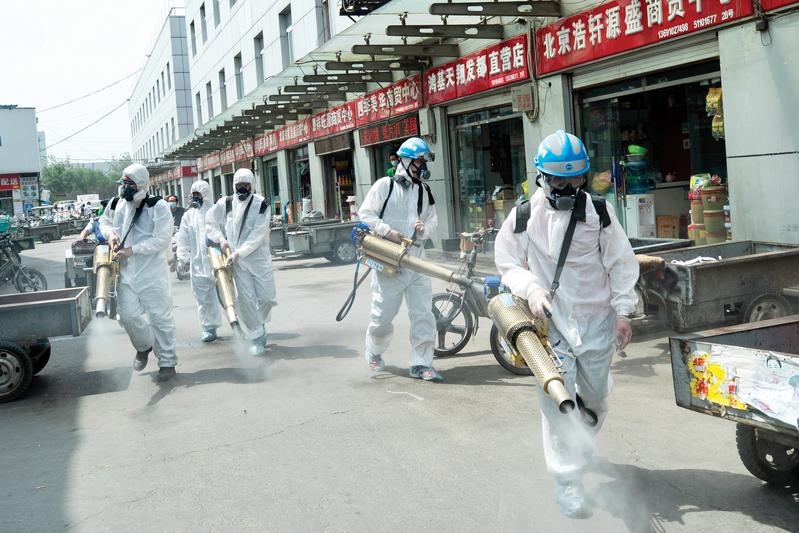Source ‘unlikely’ to be salmon; strain appears to have European origins
 Workers disinfect the Yuegezhuang wholesale market in Beijing’s Fengtai district on June 16. (ZOU HONG / CHINA DAILY)
Workers disinfect the Yuegezhuang wholesale market in Beijing’s Fengtai district on June 16. (ZOU HONG / CHINA DAILY)
Beijing is taking swift steps to curb a new cluster of local COVID-19 infections that has broken out in the capital, including shuttering a major wholesale market linked to all new infections, imposing a partial lockdown in its vicinity and ramping up mass testing and screening in key areas.
On June 16, the city raised its public health emergency response from the third to the second level with the number of confirmed cases in the city exceeding 100 over the past five days, a senior official announced.
Chen Bei, deputy secretary-general of the Beijing municipal government, said at a news conference on June 16 that people should not leave Beijing unless their trip is essential.
All the new cases are related to the Xinfadi wholesale market in southern Fengtai district. The cluster of infections is believed to be associated with human-to-human transmission and contaminated objects, Chen said.
Shi Guoqing, deputy director of the emergency center of the Chinese Center for Disease Control and Prevention, said the novel coronavirus was found on salmon cutting boards at the Xinfadi market, and it was not discovered before the salmon entered the market.
The capital reported 36 new patients with COVID-19 on June 14, the majority of whom worked at or had been to the Xinfadi market.
Beijing reported 27 new COVID-19 patients on June 15, bringing the total of confirmed cases to 106 since the first new local case was reported on June 11, after 57 successive days without new cases in the city.
“Beijing is facing a very serious epidemic situation,” Xu Hejian, a spokesman for the municipal government, said at a news conference on COVID-19 on June 16.
Shandong, Zhejiang, Sichuan, Liaoning, Heilongjiang and Fujian provinces and Shanghai have introduced a range of quarantine measures for travelers from Beijing.
Earlier, Xu said this outbreak is closely related to the Xinfadi market and the government would employ the strictest investigation to find the source of the infection and curb the spread of the virus.
The city’s authorities announced several measures under the second level of the public health emergency response. Residents of Beijing’s medium and high-risk areas, as well as those related to the Xinfadi market, should not leave Beijing. Other residents should not leave the city if the trip is not necessary.
Nearly 8,000 people who run businesses or make purchases in Xinfadi had received nucleic acid tests by June 14 and had been transferred to isolation locations for centralized medical observation.
Up to 90,000 residents living in 21 communities near Xinfadi and Yuquandong — another market whose operations have been suspended due to the new COVID-19 infections in the capital — were receiving nucleic acid tests. All those communities are closed and under strict management.
Zeng Guang, a senior researcher at the Chinese Center for Disease Control and Prevention, said on June 14 that, based on preliminary analysis of the two early cases, the coronavirus strain in the latest outbreak is different from the ones found in China, and early data suggest it is a mutated variety from Europe.
However, Zeng stressed that people should take this finding with a grain of salt as more testing is being conducted to confirm the virus origin.
Wu Zunyou, the chief epidemiologist at the CDC, said in a statement on June 13 that fish in their natural habitat cannot catch coronavirus – however they can be contaminated by workers during capture or transportation.
China imports about 80,000 tons of cooled and frozen salmon each year, according to news site Jiemian.com. Chile, Norway, the Faroe Islands, Australia and Canada are the main sources of salmon imports.
Wu said it cannot be concluded that salmon is the source of infection just because novel coronavirus was detected on cutting boards. “Our seafood products are typically stored and transported in cold containers, thus it is possible for the virus to be preserved for a long time and increase the likelihood of infecting people.”
Wu said Beijing’s new outbreak could have two possible explanations. The first may be the influx of meat and seafood to the market from all over the country and around the world. Some of it may have been contaminated by workers during processing and transportation, then the virus jumped from produce to people.
The second possibility is person-to-person transmission. “The infected person who brought the virus into the market might be asymptomatic or have very mild symptoms, and the hustle and bustle of the market led to the cluster of new infections,” he said.
Zhang Zhihao and Xinhua contributed to this story.


